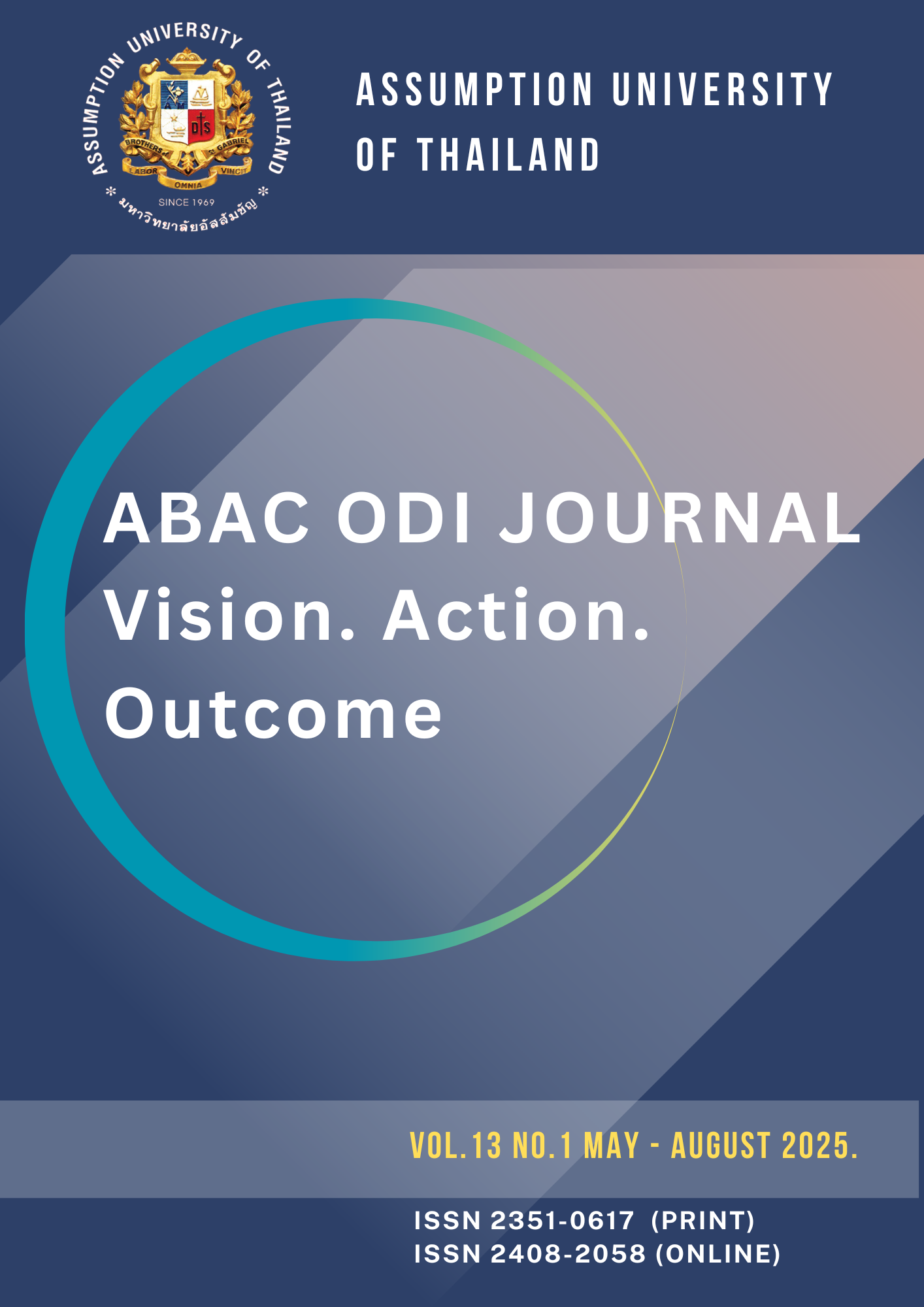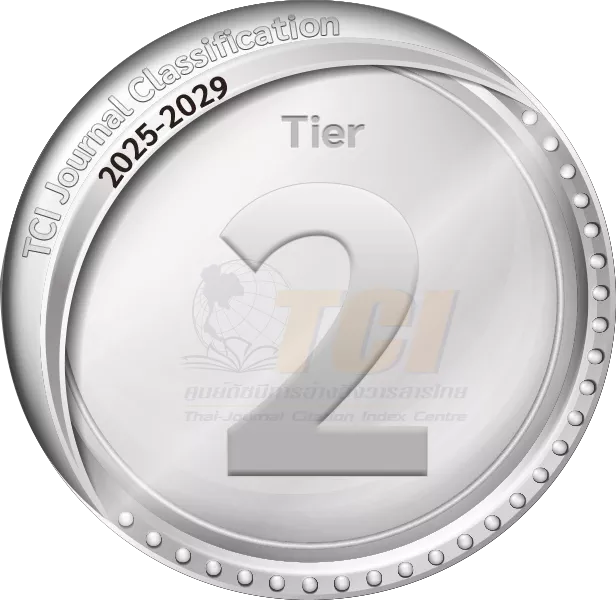Factors Affecting Students’ Satisfaction in Design Courses; A Case Study of University Students in Chengdu, China
DOI:
https://doi.org/10.14456/abacodijournal.2025.31Keywords:
Student Satisfaction, Perceived Value, Teaching Quality, Learning Resources, Instructor, Course Content, TechnologyAbstract
The purpose of this study is to investigate how students' satisfaction is affected by six independent variables: namely perceived value, teaching quality, learning resources, instructors, course content, and technology. The study mainly adopts the questionnaire survey method, comprehensive research combining quantitative and qualitative approaches, to explore the factors influencing the satisfaction of students majoring in design at Sichuan University of Media and Communications (SUMC), and to improve students' satisfaction by implementing strategic plans. Cronbach's Alpha was employed as a pilot test (n=30) and the Item-Objective Congruence (IOC) was employed to assess the validity of this study. Then, 90 valid questionnaires were collected from SUMC. Multiple linear regression was used to analyze the quantitative data to verify the hypotheses. Subsequently, a group of 30 students participated in the implementation of a strategic plan for 16 weeks. The strategic plan stage was designed based on the results of multiple linear regression. Data were collected through questionnaires and structured interviews, and then the paired samples t-test was used to compare the results of the quantitative data before and after the strategic planning. Multiple linear regression results show that perceived value, teaching quality, learning resources, and instructors have significant effects on student satisfaction, while course content and technology have no significant effects on student satisfaction. Finally, the comparison results of the paired sample T-test show significant differences in perceived value, teaching quality, learning resources, and instructors in the post-strategic and pre-strategic planning stages.
References
Alves, H. (2011). The measurement of perceived value in higher education: A unidimensional approach. The Service Industries Journal, 31(12), 1943-1960.
https://doi.org/10.1080/02642069.2011.550042
Annamdevula, S., & Bellamkonda, R. S. (2016). Effect of student perceived service quality on student satisfaction, loyalty and motivation in Indian universities: Development of HiEduQual. Journal of Modelling in Management, 11(2), 488-517.
Appuhamilage, K. S. M., & Torii, H. (2019). The impact of loyalty on the student satisfaction in higher education: A structural equation modeling analysis. Higher Education Evaluation and Development, 13(2), 82-96.
Bardhoshi, G., & Erford, B. T. (2017). Processes and Procedures for Estimating Score Reliability and Precision. Measurement and Evaluation in Counseling and Development, 50(4), 256-263. https://doi.org/10.1080/07481756.2017.1388680
Berk, R. A., & McKeachie, W. J. (2013). Top 10 flashpoints in student ratings and the evaluation of teaching: What faculty and administrators must know to protect themselves in employment decisions. Routledge.
Bradford, G., & Wyatt, S. (2010). Online learning and student satisfaction: Academic standing, ethnicity and their influence on facilitated learning, engagement, and information fluency. The Internet and Higher Education, 13(3), 108-114.
Burgess, A., Senior, C., & Moores, E. (2018). A 10-year case study on the changing determinants of university student satisfaction in the UK. PloS One, 13(2), e0192976.
Chen, P.-Y., Pham, L., Cousins, B., & Bui, C. (2017). Student Satisfaction and Its Antecedents: How Does Student Satisfaction Index Model Matter in the Context of Joint Master’s Degree Programs in Vietnam. International Journal of Business & Applied Sciences, 6(2). https://search.ebscohost.com/login.aspx?direct=true&profile=ehost&scope=sit e&authtype=crawler&jrnl=24718858&AN=127892764&h=eJiocKqNCfVmEcJoDlhTlANWx7a2A2RZp3CHZb16UkOG%2FKchqcLGGlkTZZ2dIOeVAYPaieT1MM%2Bpapb9jXYUaA%3D%3D&crl=c
Coe, R., Aloisi, C., Higgins, S., & Major, L. E. (2014). What makes great teaching? Review of the underpinning research. Sutton Trust.
https://durham-repository.worktribe.com/output/1607293
Cohen, J. (2013). Statistical power analysis for the behavioral sciences. routledge. https://www.taylorfrancis.com/books/mono/10.4324/9780203771587/statistical-power-analysis-behavioral-sciences-jacob-cohen
Crosby, R. M. H. (2000). AMEE Guide No 20: The good teacher is more than a lecturer - the twelve roles of the teacher. Medical Teacher, 22(4), 334-347.
https://doi.org/10.1080/014215900409429
Darling-Hammond, L. (2017). Teacher education around the world: What can we learn from international practice? European Journal of Teacher Education, 40(3), 291-309.
https://doi.org/10.1080/02619768.2017.1315399
Dodds, W. B., & Monroe, K. B. (1985). The effect of brand and price information on subjective product evaluations. ACR North American Advances.
Drago, W., Peltier, J., & Sorensen, D. (2002). Course content or the instructor: Which is more important in on-line teaching? Management Research News, 25(6/7), 69-83.
Encabo, H. C. (2011). Canonical correlation analysis of student perception on instructional quality and satisfaction. JPAIR Multidisciplinary Journal, 6(1), 1-1.
Farahmandian, S., Minavand, H., & Afshardost, M. (2013). Perceived service quality and student satisfaction in higher education. Journal of Business and Management, 12(4), 65-74.
Field, A. (2024). Discovering statistics using IBM SPSS statistics. Sage publications limited. https://www.google.com/books?hl=zh-CN&lr=&id=83L2EAAAQBAJ&oi=fnd&pg=PT8&dq=+Field,+A.+(2018).+*Discovering+Statistics+Using+IBM+SPSS+Statistics*.+Sage.++&ots=UbMQDoBIyH&sig=_ke06Gp1MII4kfkZlL4Xba8SY2M
Hair, J., Sarstedt, M., Hopkins, L., & G. Kuppelwieser, V. (2014). Partial least squares structural equation modeling (PLS-SEM) An emerging tool in business research. European Business Review, 26(2), 106-121.
Halimatussakdiah, N. A., Majid, M. S. A., & Azis, N. (2020). Mediating effect of student perceived value on student satisfaction in the Indonesian private higher education institutions. International Journal of Management in Education, 14(6), 611. https://doi.org/10.1504/IJMIE.2020.110691
Han, X., Xie, T., & Hai, E. (2020). An analysis of the problems and countermeasures in the teaching reform of colleges and universities. Look at the World.
Han, Y. (2020). Research on the current situation, problems and countermeasures of the allocation of higher—Education resources in China. Education Digest, 35(7).
Harsasi, M., & Sutawijaya, A. (2018). Determinants of student satisfaction in online tutorial: A study of a distance education institution. Turkish Online Journal of Distance Education, 19(1), 89-99.
Hasan, H. F. A., Ilias, A., Rahman, R. A., & Razak, M. Z. A. (2008). Service quality and student satisfaction: A case study at private higher education institutions. International Business Research, 1(3), 163-175.
Horsley, M., Knight, B., & Huntly, H. (2010). The role of textbooks and other teaching and learning resources in higher education in Australia: Change and continuity in supporting learning. https://acquire.cqu.edu.au/articles/journal_contribution/The_role _of_textbooks_and_other_teaching_and_learning_resources_in_higher_education_in_Australia_change_and_continuity_in_supporting_learning/13456196
Hsu, Y.-C., Hung, J.-L., & Ching, Y.-H. (2013). Trends of educational technology research: More than a decade of international research in six SSCI-indexed refereed journals. Educational Technology Research and Development, 61(4), 685-705.
https://doi.org/10.1007/s11423-013-9290-9
Jeong, H., & Hmelo-Silver, C. E. (2010). Productive use of learning resources in an online problem-based learning environment. Computers in Human Behavior, 26(1), 84-99.
Kane, T. J., Rockoff, J. E., & Staiger, D. O. (2008). What does certification tell us about teacher effectiveness? Evidence from New York City. Economics of Education Review, 27(6), 615-631.
Kim, B., & Reeves, T. C. (2007). Reframing research on learning with technology: In search of the meaning of cognitive tools. Instructional Science, 35(3), 207-256.
https://doi.org/10.1007/s11251-006-9005-2
Kotler, P., & Clarke, R. N. (1986). Marketing for health care organizations. Prentice Hall. https://www.scholars.northwestern.edu/en/publications/marketing-for-health-care-organizations
Lajoie, S. P. (2013). Computer Environments as Cognitive Tools for Enhancing. In Computers as cognitive tools (pp. 261-288). Routledge.
Lazar, S. (2015). The importance of educational technology in teaching. International Journal of Cognitive Research in Science, Engineering and Education, 3(1), 111-114.
Lo, C. C. (2010). How student satisfaction factors affect perceived learning. Journal of the Scholarship of Teaching and Learning, 47-54.
Lou, M. (2017). A Virtual Reality Teaching System for Graphic Design Course. International Journal of Emerging Technologies in Learning, 12(9), 117.
Martín-Rodríguez, Ó., Fernández-Molina, J. C., Montero-Alonso, M. Á., & González-Gómez, F. (2015). The main components of satisfaction with e-learning. Technology, Pedagogy and Education, 24(2), 267-277. https://doi.org/10.1080/1475939X.2014.888370
Mfon, A. A., & Ekong, J. (2021). Service Delivery and Students Satisfaction in Obio Akpa Campus of Akwa Ibom State University. AKSU Journal of Administration and Corporate Governances, 1(2), 39-56.
Mornoe, K. B., & Chapman, J. D. (1987). Framing effects on buyers’ subjective evaluations. Advances in Consumer Research, 14, 193-197.
Mulyono, H., Hadian, A., Purba, N., & Pramono, R. (2020). Effect of service quality toward student satisfaction and loyalty in higher education. The Journal of Asian Finance, Economics and Business (JAFEB), 7(10), 929-938.
Neter, J., Wasserman, W., & Kutner, M. H. (1983). Applied linear regression models. Richard D. Irwin. https://worldveg.tind.io/record/4336/
Njoroge, J., Norman, A., Reed, D., & Suh, I. (2012). Identifying Facets of Technology Satisfaction: Measure Development and Application. Journal of Learning in Higher Education, 8(2), 7-17.
Phenix, P. H. (1962). The Use of the Disciplines as Curriculum Content. The Educational Forum, 26(3), 273-280. https://doi.org/10.1080/00131726209338539
Rodríguez, R., & Rubio, G. (2016). Teaching quality and academic research. International Review of Economics Education, 23, 10-27.
Rovinelli, R. J., & Hambleton, R. K. (1976). On the use of content specialists in the assessment of criterion-referenced test item validity. https://eric.ed.gov/?id=ED121845
Rys, M. E., Fredericks, J. O., & Luery, D. A. (1987). Value= quality? Are service value and service quality synonymous: A decompositional approach. Add Value to Your Service, 25-28.
Senge, P. M. (1990). The Leader’s New Work: Building Learning Organizations. MIT Sloan Management Review, 32(1), 7.
Sheu, T.-S. (2010). Exploring the Differential Affections of Service Quality, Sacrifice, Perceived Value, and Customer Satisfaction on University Students’ Favorable and Unfavorable Behavioral Intentions. 品質學報, 17(6), 483-500.
Siragusa, L., Dixon, K. C., & Dixon, R. (2007). Designing quality e-learning environments in higher education. Proceedings Ascilite Singapore, 923-935.
Spooren, P., Brockx, B., & Mortelmans, D. (2013). On the Validity of Student Evaluation of Teaching: The State of the Art. Review of Educational Research, 83(4), 598-642. https://doi.org/10.3102/0034654313496870
Spreng, R. A., Dixon, A. L., & Olshavsky, R. W. (1993). The impact of perceived value on consumer satisfaction. Journal of Consumer Satisfaction, Dissatisfaction and Complaining Behavior, 6, 50-55.
Spreng, R. A., & Mackoy, R. D. (1996). An empirical examination of a model of perceived service quality and satisfaction. Journal of Retailing, 72(2), 201–214.
Stronge, J. H. (2018). Qualities of effective teachers. Ascd.
https://www.google.com/books?hl=zh-CN&lr=&id=x7RUDwAAQBAJ&oi=fnd&pg= PP1&dq=Qualities+of+Effective+Teachers&ots=ieA_Htd2f6&sig=hQHweZloGibpKSQ7Pta5iT4u4So
Suarman, S., Aziz, Z., & Yasin, R. M. (2013). The quality of teaching and learning towards the satisfaction among the university students. Asian Social Science, 9(12), 1911-2017.
Teas, R. K., & Agarwal, S. (1997). Quality cues and perceptions of value: An examination of the mediation effects of quality and sacrifice perceptions. Iowa State University Working Paperd, 37(6).
Ten Eyck, R. P., Tews, M., & Ballester, J. M. (2009). Improved medical student satisfaction and test performance with a simulation-based emergency medicine curriculum: A randomized controlled trial. Annals of Emergency Medicine, 54(5), 684-691.
Turner, R. C., & Carlson, L. (2003). Indexes of Item-Objective Congruence for Multidimensional Items. International Journal of Testing, 3(2), 163-171. https://doi.org/10.1207/S15327574IJT0302_5
Ueno, S., & Sekaran, U. (1992). The Influence of Culture on Budget Control Practices in the USA and Japan: An Empirical Study. Journal of International Business Studies, 23(4), 659-674. https://doi.org/10.1057/palgrave.jibs.8490282
Witowski, L. L. (2008). The relationship between instructional delivery methods and student learning preferences: What contributes to student satisfaction in an online learning environment? [PhD Thesis]. Capella University.
Yuanbo, Z., & Pongsatha, S. (2023). Factors Impacting on Art Major Postgraduate Students’ Satisfaction to Online Learning in Chengdu of China. ABAC ODI Journal Vision. Action. Outcome, 10(2), 17-32.
Zaheer, M., Babar, M. E., Gondal, U. H., & Qadri, M. M. (2015). E-learning and student satisfaction. Proceedings of the 29th Annual Conference of the Asian Association of Open Universities: New Frontiers in ODL, 275-285.
https://www.researchgate.net/profile/Muhammad-Zaheer-23/publication/29540 0881_E-Learning_and_Student_Satisfaction/links/5f995c18a6fdccfd7b84cf68/E-Learning-and-Student-Satisfaction.pdf
Zeithaml, V. A. (1988). Consumer Perceptions of Price, Quality, and Value: A Means-End Model and Synthesis of Evidence. Journal of Marketing, 52(3), 2-22.




